Benjamin Sobieck's Blog, page 22
July 9, 2014
Examining the Lever-Action Shotgun from Terminator 2
It's clunky, hard to operate and a relic from the 1800s. So of course a time-traveling robot from the future would use it.
"I'll be back" is the famous Arnold Schwarzenegger line from the Terminator movies, but can you name the iconic shotgun from the second film? That's it in Ah-nold's right hand on the movie poster.

It's a lever-action Winchester Model 1887. Here's the scene from the movie that helped make it famous.
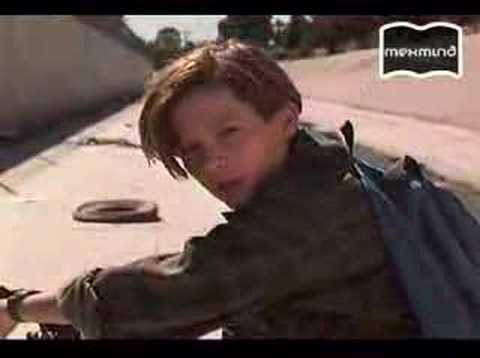
As this video from the National Firearms Museum points out, it likely made its way onto the silver screen for looks. It's actually pretty clunky to operate. Not even its designer, John Browning, was all that fond of it.
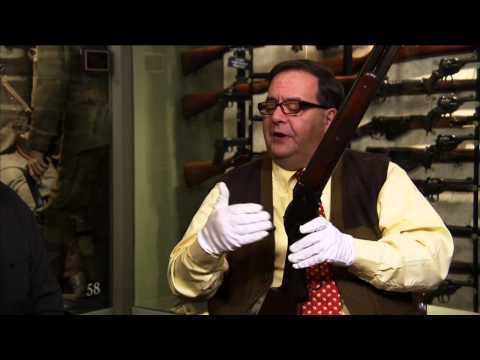
Despite its name, many Model 1887s are still in circulation, and new clones continue to be manufactured. For writing fiction, it'd be available for characters in settings from 1887 through today.
However, a character using a Model 1887 needs to be strong and able, sort of like a Terminator. Working the large lever-action, as the next video demonstrates, is a chore. A pump-action shotgun might be a better fit if the character isn't cut out for the Model 1887.
Here's a video from a Guns of the Old West magazine editor firing one of the newer clones. Note how easy it jams and how difficult it is to reload.

Is the Model 1887 the right fit for one of your characters? In my work-in-progress crime novel, I give everyone pump-action shotguns. They're popular, easy to use and reliable. But that's just me. What do you think?
If you enjoyed this article, sign up for my free e-newsletter. You'll get great content like this delivered right to your inbox. I'll even give you an e-book on the house for signing up. Keen!
July 8, 2014
Video: A Better Way to Shoot a Handgun from a Pocket
Following up on the post about making shots from inside a pocket, here's a product that could help characters do just that. It's called the DeSantis Pocket Shot. The demonstration shows how to draw and fire a handgun in a pocket, but I'm thinking fiction could come up with reasons to skip that first step.
This holster would be ideal for assassin and spy characters, methinks. Just make sure the holster is available for the pistol the character is using. Check out the DeSantis order page for those details. There are only 12 models available, which isn't much, but should be enough if a scene calls out for a product like this one.
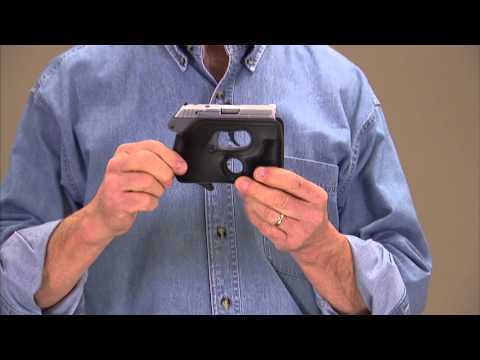
July 2, 2014
We Have a Cover!
The Weapons for Writers: A Practical Reference for Using Firearms and Knives in Fiction officially has a cover. It's up at Amazon. Whether this is the final-final remains to be seen (publishers sometimes swap covers before it goes to print), but I like what's going on in this one. Check out the gun schematic in the background. Keen!
June 25, 2014
Semi-Auto Pistol or Revolver? It Can Make a Big Difference
Free Kindle Crime Novels Alert!
Dana King's guest post today about handguns comes just in time for a free Kindle book giveaway. Now through Sunday, June 29, you can get all four of Dana's e-books for free exclusively on the Kindle. I've read each of these books, and Dana's noir delivery is pitch perfect. He's picking up attention from places like the L.A. Review of Books and the Shamus Awards.
Don't wait! Hop to it and click here to get the free crime novels.
~Ben
Semi-Automatic Pistol or Revolver? It Can Make a Big Difference
by Dana King
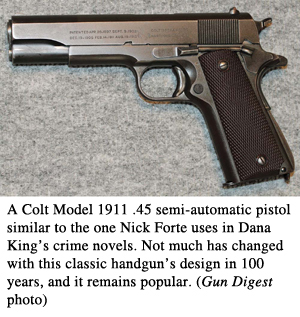
Nick Forte, the protagonist of my PI series, has a bit of a military background, and is old school to boot. His weapon of choice is a classic M1911 .45 caliber Army Colt Pistol (ACP). Nick figures, if it was a good enough sidearm to be standard issue for 74 years and five wars, it’s good enough for him. (Some U.S. troops still use the M1911.)
A problem arose for me when I had a scene firm in my mind, a good combination of action with dark humor built in, but it depended on Forte not being aware he had run out of ammunition.
The M1911 is a semi-automatic; the slide locks open when the last round in the magazine has been fired. How to get around this?
(Ben says: Here's a video from Youtube that demonstrates the slide locking open after the last round is fired. Pardon the Metallica.)
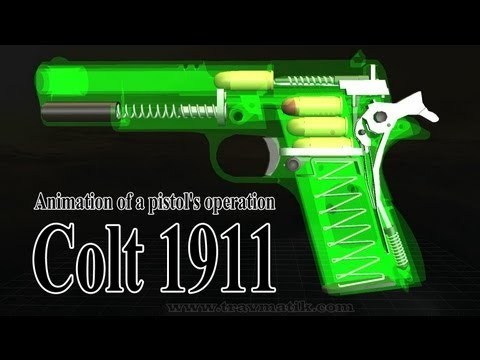
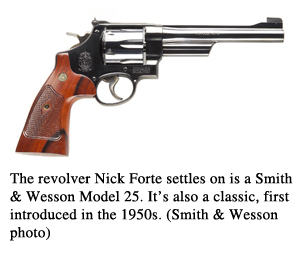 As luck would have it, I had decided to expand Nick’s detective agency for this story. The new employee is Delbert McCall, a retired second-generation Texas Ranger who’s even more old school than Nick: he doesn’t trust automatics, ever since his daddy had one jam on him and had to beat the suspect into submission with it.
As luck would have it, I had decided to expand Nick’s detective agency for this story. The new employee is Delbert McCall, a retired second-generation Texas Ranger who’s even more old school than Nick: he doesn’t trust automatics, ever since his daddy had one jam on him and had to beat the suspect into submission with it.
Nick being a Colt man and all, Delbert tries to talk him into an Anaconda revolver, but Nick isn’t comfortable carrying three pounds of .44 Magnum under his arm. They compromise on a Smith and Wesson Model 25, a .45 like the M1911; even takes the same cartridges.
Now, when Nick has fired all six rounds, he is unaware, and the scene works. This had the added benefit of allowing me to write two nice scenes around it: one when Delbert talks Nick into the revolver; the other when Nick gets rid of it.
-30-
Dana King is the author of Wild Bill, Worst Enemies, Grind Joint and Small Sacrifice, the latter of which was nominated for a Shamus Award. Find his blog at One Bite at a Time.
June 24, 2014
Video: Knife Throwing with the Son of Maynard('s Voice)
This is cool. Geoff Metcalf, the man with the golden pipes currently recording the Maynard Soloman, gal-damn detective audiobook, shot this video of his deadeye son throwing a knife. Says Geoff, "My son has Cerebral Palsy and cannot walk without crutches so I couldn't teach him to ride a bike. Instead I taught him this…"
June 23, 2014
Reminder: Pre-Order The Weapons for Writers
It doesn't have an official cover yet, but you can pre-order my forthcoming opus, The Weapons for Writers: A Practical Reference for Using Firearms and Knives in Fiction, published by Writer's Digest, through Amazon here.
Whew, that's a lot of links for one sentence.
June 21, 2014
On the Cover of the Rolling Stone...
...of gun magazines. Look who made the Gun Digest Facebook feed firing a few rounds from a Glock. This was taken at a gun range near my work a few years ago. The Glock belonged to a co-worker. It was a treat to shoot.
[image error]
June 20, 2014
Read This Fantastic Noir Anthology, Support Charity
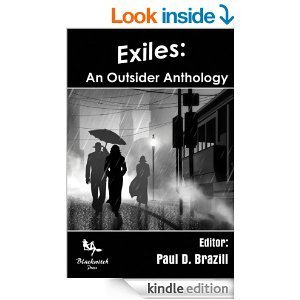 New release alert! Exiles: An Outsider Anthology rounds up the best and brightest of the crime fiction/noir universe for one fantastic anthology. You'll find short, crime-y tales inside - including one from me. Edited by Paul D. Brazill, the godfather of the online crime fiction writing community, it's available now for the Kindle and in print.
New release alert! Exiles: An Outsider Anthology rounds up the best and brightest of the crime fiction/noir universe for one fantastic anthology. You'll find short, crime-y tales inside - including one from me. Edited by Paul D. Brazill, the godfather of the online crime fiction writing community, it's available now for the Kindle and in print.
Here's the official Amazon description, including the roster:
Exiles is a collection of 26 short stories, all featuring the common theme of 'outsiders'.
Dedicated to Jeff Luke and Colin Graham. All proceeds go to the Marfan Foundation, in aid of people suffering from Marfan syndrome.
INTRODUCTION: HEATH LOWRANCE
REFLECTIONS ON A DECADE IN THE WILD EAST – COLIN GRAHAM
EATING THE DREAM – K A LAITY
MIDNIGHT TRAIN TO DELHI – CHRIS RHATIGAN
BOXING DAY IN MUROS – STEVEN PORTER
WE ARE ALL SPECIAL CASES – PATTI ABBOTT
NEVER A VESSEL LARGE ENOUGH – RYAN SAYLES
THE SOLOMON SEA – GARETH SPARK
AGENT RAMIEL GETS THE CALL – PAMILA PAYNE
THE WEATHER PROPHET – PAUL D. BRAZILL
THE RAIN KING – JASON MICHEL
DULLCREEK – CARRIE CLEVENGER
IN AMERICA – DAVID MALCOLM
THE PLACE OF THE DEAD – NICK SWEENEY
DISAPPEARING ACT – SONIA KILVINGTON
WHAT FRIENDS ARE FOR – ROB BRUNET
PACIFIC COAST HIGHWAY – JAMES A. NEWMAN
DEAD MAN WALKING – TESS MAKOVESKY
SHUT OUT THE LIGHT – CHRIS LEEK
FLYING IN AMSTERDAM – MCDROLL
THE TRIBE – RENATO BRATKOVIC
WETWORK – WALTER CONLEY
DIGGER DAVIES – MARIETTA MILES
TAKING OUT THE TRASH – AIDAN THORN
MISSING AN EAR – BENJAMIN SOBIECK
THE TENDER TRAP – GRAHAM WYND
FALLING THROUGH THE HOURGLASS – RICHARD GODWIN
June 17, 2014
The Best Handgun for Female Detective Characters is Not Pink
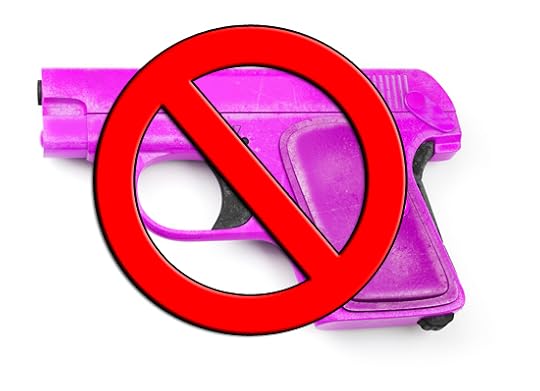
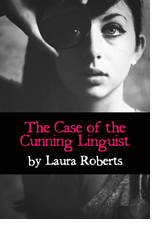 Pink firearms and knives are marketing tools whose most practical use is gnawing out a discussion about gender in the sporting goods department. I'll save that for another day and let writer bud Laura Roberts explain how she settled on a handgun for her female detective character, Venus Delmar. Roberts took the time to research the perfect Glock - and it sure in the red hell ain't pink.
Pink firearms and knives are marketing tools whose most practical use is gnawing out a discussion about gender in the sporting goods department. I'll save that for another day and let writer bud Laura Roberts explain how she settled on a handgun for her female detective character, Venus Delmar. Roberts took the time to research the perfect Glock - and it sure in the red hell ain't pink.
You can read all about Delmar's saucy adventures and sex-themed punnery in Roberts' serial novel, The Case of the Cunning Linguist . I highly recommend subscribing to each installment of the novel on Jukepop. It's a fun way to read the story one chapter at a time. I'm a fan of Roberts' work anyway (read my reviews here, here and here), and the new chapters of Linguist are a highlight of my week.
~Ben
***
The Best Handgun for Female Detective Characters Isn't Pink
I'll be the first to admit, I'm no expert on matching weapons with characters. In fact, I asked Ben for some advice on the subject when I was brainstorming ideas for my latest work, The Case of the Cunning Linguist.
My main character is Venus Delmar, a stripper-turned-sleuth who lives in Paris. She's not an ex-cop, like many PIs, just a woman who knows her way around some sleazy dives and shady dealers.
In short, she's a woman who wants to be taken seriously in a man's world. What kind of gun would work best for such a situation?
James Bond's .25 Beretta: A "Lady's Gun"
At first I was tempted by a .25 Beretta. I had read a great letter to Ian Fleming on Letters of Note, where the infamous author was chastised for arming James Bond with a "lady's gun, and not a really nice lady at that." I liked the idea of swiping Bond's original gun for Venus -- a woman who most would probably consider a "not really nice lady," given her stripper past and propensity to stash her handgun in a garter.
Of course, given the fact that the letter writer helped Fleming choose a more suitable weapon for 007, and in the rest of his outings Bond carries a Walther PPK, the Beretta connection is lost. A bit of a dead end for my lady PI.
And, really, why should James Bond have all the fun of choosing weapons? Venus still needed to find a gun to fit her lifestyle and personality.
I began Googling images of the Walther, to see what the gun actually looked like. Having never set foot in a gun shop, much less taken a day at a shooting range, my knowledge of guns is strictly limited to the fictional realm. I wanted to get a good visual of Bond's gun to keep on brainstorming ideas for Venus.

Start with Size First
As Ben suggests, part of the process of choosing a gun for your character involves checking out the size of the weapon. I imagine Venus has relatively small hands, so the original Beretta idea made sense for her. She's also more likely to need a gun for stealth than cop-like bluster, so she wouldn't want anything too flashy. But what do cops carry, anyway?
Glocks.
I headed to the Glock website to check out some of the company's offerings. They had a few suggested specifically for women, but I liked the idea of bucking their system and checking out the rest of the merchandise instead. Venus would surely sneer at being steered towards the "lady's guns," in any shop. What next, a pink pistol?
The Pick: Glock 36
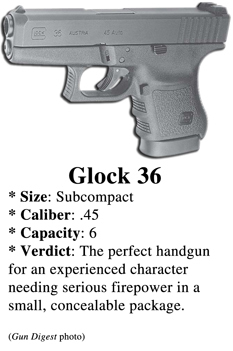
After much browsing, I finally settled on the Glock 36. The matte black finish looked great for a user concerned with stealth, and the gun is small enough for a woman's hands without being cute. In fact, the G36 is billed as "easy-to-use, hard to see, and tough to face" -- perfect for a woman looking to be taken seriously whenever she points the weapon at your skull.
Though I don't anticipate Venus needing to blow anyone's head off in my novel (which is, after all, set mainly in a Gothic cathedral in France), I like the idea of sending a strong message with her weapon of choice. She's a lady who doesn't mess around, and her gun should be, too. All the better if she need not fire a single round to get her point across.
-30-
[image error]Laura Roberts writes about sex, travel and ninjas -- though not necessarily in that order. Her current WIP, The Case of the Cunning Linguist, is available in serial format at Jukepop. For those who prefer to read it all in one shot, print and ebook pre-orders are available at Buttontapper.com.
May 15, 2014
What, Exactly, is a Switchblade?
Fiction just loves switchblades. That's why there's a whole section on them in The Weapons for Writers, the guide to firearms and knives I wrote that Writer's Digest will publish later this year. (Shameless plug: pre-order it here from Amazon.)
Ahead of that, I want to get a little primer on switchblades out there first. I was reading a thriller last night where a character popped open a switchblade to slit the throat of someone pinned in a car wreck. (Took a lot of guts to do that, chump.) There's nothing wrong with that passage, but it made me wonder if writers and readers know what it is that makes a knife a switchblade.
Switchblades' Two Key Features
When most people picture a switchblade, they imagine something like this Shutterstock pic:
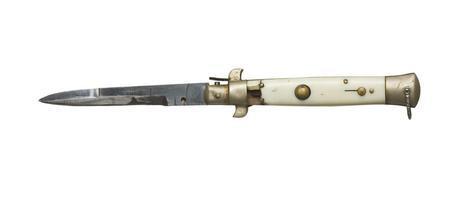
That's a particular style of knife called an Italian stiletto, and it's a cosmetic thing. That a knife looks like that doesn't make it a switchblade.
By federal definition under the 1958 Switchblade Act, a switchblade sports two important features:
1) It contains a blade concealed inside a handle biased to come out of the handle.
2) The blade is released when a button, switch or other device on the handle is pressed. (You can see the big brass button on the handle in the pic above.)
If a knife doesn't have both of those features, it's not a switchblade. I italicized those bits because they separate switchblades from assisted openers. More on those later.
Switchblades: Mostly Dead
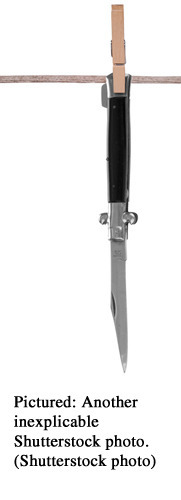 In 1958, for reasons I go into in the guide, switchblades were prohibited by federal law. However, this only applied to interstate commerce. States could still determine their own switchblade laws, although most opted to restrict them. That means switchblades are, as Billy Crystal in The Princess Bride would say, only mostly dead across the U.S.
In 1958, for reasons I go into in the guide, switchblades were prohibited by federal law. However, this only applied to interstate commerce. States could still determine their own switchblade laws, although most opted to restrict them. That means switchblades are, as Billy Crystal in The Princess Bride would say, only mostly dead across the U.S.
Some states, such as New Hampshire, and municipalities allow civilian switchblade commerce and possession. Those new models are generally limited to short or custom runs. Most switchblades in circulation elsewhere are antiques.
More common are "automatic knives." That's the term for modern, manufactured switchblades. They're sold to military and law enforcement organizations. They look nothing like Italian stilettos. They're more in line with typical folding knives, with the exception that they contain those two points mentioned above. It follows that military and law enforcement characters would have no problem obtaining automatic knives. It's still accurate to call them "switchblades," but writing "automatic knives" instead will lend a nice touch.
It's Time to Phase Out Switchblades
Although they're popular in fiction, I think it's time to phase switchblades out for characters without access to automatic knives (i.e. not law enforcement or military characters). From a practical standpoint, they fail during hard use and don't always open as the springs wear out. Laws limit their availability to the average Joe and lowlife, leaving a pool of antiques in circulation to withstand the rigors of crime fiction. Switchblades' association with crime and fiction is left over from mid-20th century pop culture. Times - and technology - have moved on.
Assisted opening knives are the better option for fiction's protagonists and assorted bad guys. They function almost identically to switchblades without the legal restrictions. They gained popularity in the late '90s and were exempted in 2009 from the 1958 Switchblade Act.
I'll cover assisted opening knives in another post. In the meantime, you can pre-order The Weapons for Writers from Writer's Digest on Amazon here.
If you enjoyed this article, be sure to sign up for my free e-newsletter. You'll get helpful tidbits like this and more. I'll even give you a free e-book when you sign up. Keen!

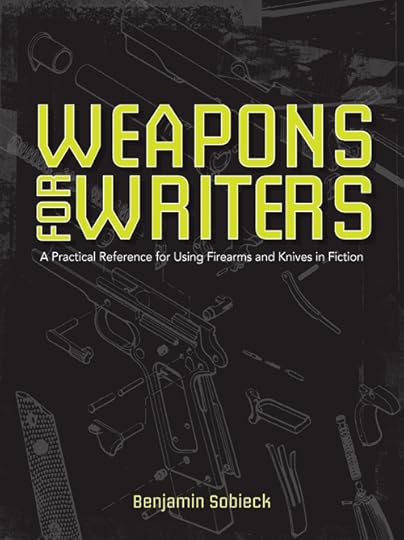
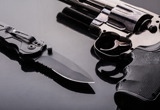
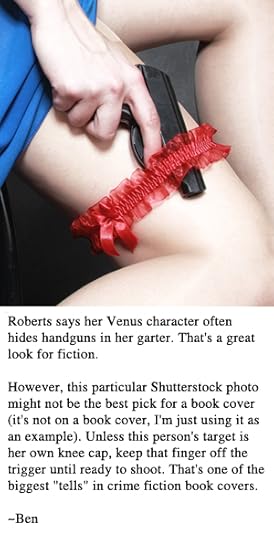 by
by 

